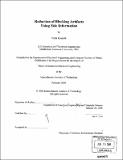| dc.contributor.advisor | Jae S. Lim. | en_US |
| dc.contributor.author | Kamışlı, Fatih | en_US |
| dc.contributor.other | Massachusetts Institute of Technology. Dept. of Electrical Engineering and Computer Science. | en_US |
| dc.date.accessioned | 2007-01-10T16:46:37Z | |
| dc.date.available | 2007-01-10T16:46:37Z | |
| dc.date.copyright | 2006 | en_US |
| dc.date.issued | 2006 | en_US |
| dc.identifier.uri | http://hdl.handle.net/1721.1/35602 | |
| dc.description | Thesis (S.M.)--Massachusetts Institute of Technology, Dept. of Electrical Engineering and Computer Science, 2006. | en_US |
| dc.description | Includes bibliographical references (p. 95-96). | en_US |
| dc.description.abstract | Block-based image and video coding systems are used extensively in practice. In low bit-rate applications, however, they suffer from annoying discontinuities, called blocking artifacts. Prior research shows that incorporating systems that reduce blocking artifacts into codecs is useful because visual quality is improved. Existing methods reduce blocking artifacts by applying various post-processing techniques to the compressed image. Such methods require neither any modification to current encoders nor an increase in the bit-rate. This thesis examines a framework where blocking artifacts are reduced using side information transmitted from the encoder to the decoder. Using side information enables the use of the original image in deblocking, which improves performance. Furthermore, the computational burden at the decoder is reduced. The principal question that arises is whether the gains in performance of this choice can compensate for the increase in the bit-rate due to the transmission of side information. Experiments are carried out to answer this question with the following sample system: The encoder determines block boundaries that exhibit blocking artifacts as well as filters (from a predefined set of filters) that best deblock these block boundaries. | en_US |
| dc.description.abstract | (cont.) Then it transmits side information that conveys the determined block boundaries together with their selected filters to the decoder. The decoder uses the received side information to perform deblocking. The proposed sample system is compared against an ordinary coding system and a post-processing type deblocking system with the bit-rate of these systems being equal to the overall bit-rate (regular encoding bits + side information bits) of the proposed system. The results of the comparisons indicate that, both for images and video sequences, the proposed system can perform better in terms of both visual quality and PSNR for some range of coding bit-rates. | en_US |
| dc.description.statementofresponsibility | by Fatih Kamisli. | en_US |
| dc.format.extent | 96 p. | en_US |
| dc.format.extent | 10907252 bytes | |
| dc.format.extent | 11143750 bytes | |
| dc.format.mimetype | application/pdf | |
| dc.format.mimetype | application/pdf | |
| dc.language.iso | eng | en_US |
| dc.publisher | Massachusetts Institute of Technology | en_US |
| dc.rights | M.I.T. theses are protected by copyright. They may be viewed from this source for any purpose, but reproduction or distribution in any format is prohibited without written permission. See provided URL for inquiries about permission. | en_US |
| dc.rights.uri | http://dspace.mit.edu/handle/1721.1/7582 | |
| dc.subject | Electrical Engineering and Computer Science. | en_US |
| dc.title | Reduction of blocking artifacts using side information | en_US |
| dc.type | Thesis | en_US |
| dc.description.degree | S.M. | en_US |
| dc.contributor.department | Massachusetts Institute of Technology. Department of Electrical Engineering and Computer Science | |
| dc.identifier.oclc | 75204248 | en_US |
